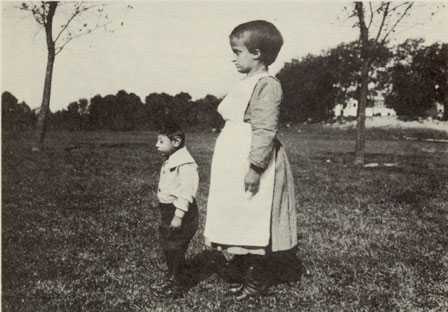Barthes’ Camera Lucida , first published in 1980, assumes that the automaticity of the camera distinguishes photography from traditional media and has significant implications for how we experience photographs. To address the apparently uncoded level of photographs, which troubles the semiological approach Barthes himself adopted in the early 1960s, Camera Lucida advances a theory of photographic meaning that makes a distinction between the studium and the punctum and highlights the punctum as photography-specific.
The studium indicates historical, social or cultural meanings extracted via semiotic analysis. For example, the photograph taken by Koen Wessing in 1979 (p. 22), portraying a war-torn street in Nicaragua with three armed soldiers patrolling the street and two nuns crossing the section of the street behind the soldiers, could be interpreted as a presence of the traditional oppositions between war and religion, violence and spirituality.
“I understood at once that this photograph’s ‘adventure’ derived from the co-presence of two elements… “
KOEN WESSING: NICARAGUA 1979
The punctum points to those features of a photograph that seem to produce or convey a meaning without invoking any recognizable symbolic system. This kind of meaning is unique to the response of the individual viewer of the image. The punctum punctuates the studium and as a result pierces its viewer. To allow the punctum effect, the viewer must repudiate all knowledge. Barthes insists that the punctum is not simply the sum of desires projected into the photograph. Instead, it arises from details that are unintended or uncontrolled by the photographer. Photography can be distinguished from painting or drawing in that its apparatus visualizes the world automatically rather than being wholly informed by the interventions of the photographer. The theory of the punctum speaks the indexical nature of the photographic medium. It also accounts for the importance of emotion and subjectivity in interacting with photographs.
Barthes offers many examples to illustrate his definition of the punctum. The first part of Camera Lucida “randomly” looks at mostly famous photographs and describes how certain details operate on the images to bring about the punctum. The second part of the book, engaging the author’s mourning for his recently deceased mother based on a photograph of her when she was five years old, the Winter Garden photograph, traces the punctum more intensively in terms of how photography represents time. It is possible to say that Camera Lucida dwells on the “that-has-been” of the photograph, which relates directly to death, reveals the ephemeral nature of life and calls us to recognize the singularity of existence. As implied from Camera Lucida, if we fail to appreciate what is specific about photography, we miss the affect that makes a photograph personally meaningful to us. It also means that we miss the chance to discover a kind of truth, the truth of unique being. The Winter Garden photograph, which is not present in the book, where Barthes discovers the truth of his mother’s face, achieves “the impossible science of the unique being” (p. 71). The punctum is not always available in our everyday existence, and Barthes describes it as life-giving.
It should be noted that presenting examples of punctum is an impossible mission. The punctum always turns into the studium when expressed in language. That is also why we may perceive that his examples do not support his theory. Rancière (2009, pp. 111) argues, “what he tells us he sees by the way of the punctum pertains to the same logic as that of the studium.” For instance, faced with a photograph of two retarded children taken by Lewis Hine in a New Jersey institution, Barthes writes: “I … hardly see the monstrous heads and pathetic profiles (which belong to the studium); what I see … is the off-centre detail, the little boy’s huge Danton collar, the girl’s finger bandage …” (p. 51). Rancière (2009) reminds us that these details are also features of disproportion and “Danton” is the proper name of a person who was decapitated. Barthes cannot dismiss knowledge as he claims. Nonetheless, he is fully aware that a theory of the punctum is not possible in language, “to give examples of punctum is, in a certain fashion, to give myself up” (p. 43).

“I dismiss all knowledge, all culture…I see only the boy’s huge Danton collar, the girl’s finger bandage…”
LEWIS H. HINE: IDIOT CHILDREN IN AN INSTITUTION. NEW JERSEY, 1924
References
Barthes, R. (2010). Camera Lucida: Reflections on photography. (R. Howard, Trans.). New York: Hill and Wang.
Rancière, J. (2009). The emancipated spectator. (G. Elliott, Trans.). New York and London: Verso.


Reblogged this on hairdressers have theories about…...
I’ve just started reading Camera Lucida but I find his comment about the photograph of the children quite funny & haven’t got to that part of the book. I find it funny because I want to know all culture & knowledge about these children – the “idiot” children – what were their names? Did they live for a long time? Were they happy? Where were their families? It’s one of the most sinister photographs I’ve ever seen – perhaps because of the title?
Pingback: Assignment 5 – Making it up | shauncn512659
Pingback: Lucy Courtney - WeAreOCA
Pingback: The Power of an Historical Image: Stretcher Bearers at Passchendaele – SySyPhoTo
Pingback: How do we read a picture? – The Media Corner
Pingback: Crítica: ‘Valley of Tears’, heroísmo, horror y afectos – NTe Radio City – Radio Catamarca
Pingback: Blog 4 Visual Methods – Rainaphoto
Pingback: MICHAEL CLARENCE: Full Catastrophe Painting – Ruminations: Exhibition Reviews